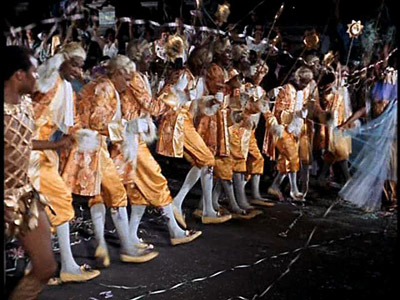Marcel Camus / France Italy Brazil / 1959 / 107 min
Available on Blu-Ray
Based on the Greek myth of Orpheus in the Underworld this is a glorious movie set in Rio at Carnival. A favourite of the New Wave brigade it won a slew of awards including the Palm d’Or at Cannes and an Oscar, and helped introduce the bossa nova (samba meets jazz) rhythm to the US and Europe. The soundtrack is by Antonio Carlos Jobim who, five years after the film was released, had a Beatles-jostling mega-hit with ‘The Girl from Ipanema’. The film opens like a travelogue sponsored by Kodachrome; the colours almost shockingly vivid; but as the story progresses things get distinctly darker with voodoo, electrocution and a midnight tour of the city morgue.
Eurydice (Marpessa Dawn) traverses the wide boulevards of downtown Rio shaded by high skyscrapers as the predominantly black population – almost all in their Sunday Best – get ready for Carnival. She is staying with her cousin hoping to evade a mysterious stalker when she meets tram driver Orfeo (Breno Mello) whose betrothed Mira (Lourdes de Oliveira) is scarlet woman to Eurydice’s Madonna in white stilettos. A cat-fight, or worse, seems inevitable.
In the late 1950s Brazil was undergoing a boom, although the workers in the filthy favelas high above Copacabana beach were horrendously exploited. The movie glosses over the poverty with stunning visuals. Often the characters’ motivations are not that convincing. It’s as if the operatic plot has kidnapped the natural human responses of attraction and jealousy. Orfeo, a leading light in the superbly named United Babylon Samba School, and costumed like a Halloween gladiator, tries to save Eurydice from a leotarded Death figure. The crowd scenes and incessant drums ratchet up the tension to a grim conclusion.
The film’s oddest failing is its depiction of the favela – Brazil’s shameful shantytowns that remained evident even during the 2016 Rio Olympics nearly 60 years after the film was released. Make a song-and-dance film (think West Side Story) by all means, but be honest. Orfeo’s shack looks as if it has the same interior decorator as Disney’s Snow White, even down to the cuddly wildlife. Director Camus was a Frenchman who, as an outsider, should have cast a colder eye on the poverty and social/racial divisions of carnival town. It’s also all too easy to deride the film’s racial stereotypes. But take the movie at face value – it’s a fantasy after all – this curio has moments of sublime elegance. And its natural warmth is just what’s needed in midwinter.
